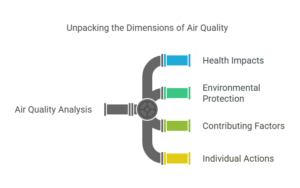Air quality analysis is a critical component in understanding the health of our environment and the well-being of its inhabitants. As urbanization and industrial activities continue to rise, the need for comprehensive air quality assessments has become increasingly urgent. These analyses provide valuable data on pollutants, particulate matter, and other harmful substances present in the atmosphere.
By systematically studying air quality, researchers and policymakers can identify trends, assess risks, and implement strategies to mitigate adverse effects on public health and the environment. Moreover, air quality analysis serves as a foundation for informed decision-making. It enables communities to understand the sources of pollution and their potential impacts.
This knowledge is essential for developing effective interventions and policies aimed at improving air quality. As such, air quality analysis is not merely a scientific endeavor; it is a vital tool for fostering healthier environments and promoting sustainable practices.
Key Takeaways
- Air quality analysis is crucial for understanding the impact of air pollution on human health and the environment.
- Poor air quality can lead to a range of health issues, including respiratory problems, heart disease, and even premature death.
- Air quality analysis plays a key role in environmental protection by identifying sources of pollution and informing regulatory measures.
- Factors such as industrial emissions, vehicle exhaust, and natural events can all affect air quality, making analysis and monitoring essential.
- Individuals can contribute to improving air quality in their communities by reducing their emissions, supporting clean energy initiatives, and advocating for policy changes.
The Impact of Air Quality on Health
The relationship between air quality and health is profound and multifaceted. Poor air quality has been linked to a range of health issues, including respiratory diseases, cardiovascular problems, and even neurological disorders. For instance, exposure to fine particulate matter (PM2.5) can lead to chronic conditions such as asthma and bronchitis, particularly in vulnerable populations like children and the elderly.
Studies have shown that long-term exposure to polluted air can reduce life expectancy and increase the risk of premature death. In addition to physical health, air quality also affects mental well-being. Emerging research suggests that air pollution may contribute to cognitive decline and mental health disorders.
For example, individuals living in areas with high levels of air pollution have been found to experience higher rates of anxiety and depression. This connection underscores the importance of maintaining clean air not only for physical health but also for overall quality of life.
The Role of Air Quality Analysis in Environmental Protection
Air quality analysis plays a pivotal role in environmental protection by providing essential data that inform conservation efforts and regulatory measures. By identifying pollutants and their sources, environmental scientists can develop targeted strategies to reduce emissions and protect ecosystems. For instance, monitoring air quality near industrial sites can help detect harmful emissions that may threaten local wildlife and plant life.
Furthermore, air quality analysis supports compliance with environmental regulations. Governments and organizations rely on accurate data to enforce laws aimed at reducing air pollution. For example, the Clean Air Act in the United States mandates regular monitoring of air quality to ensure that it meets established standards.
Through rigorous analysis, authorities can hold polluters accountable and promote practices that safeguard both human health and the environment.
Understanding the Factors Affecting Air Quality
| Factors | Impact on Air Quality |
|---|---|
| 1. Emissions from vehicles | Contribute to air pollution through the release of harmful gases |
| 2. Industrial emissions | Release of pollutants such as sulfur dioxide and nitrogen oxides |
| 3. Agricultural activities | Release of ammonia and methane affecting air quality |
| 4. Deforestation | Reduces the natural air purification process |
| 5. Weather conditions | Can affect the dispersion and concentration of pollutants |
Numerous factors influence air quality, ranging from natural phenomena to human activities. Meteorological conditions such as temperature, humidity, and wind patterns can significantly affect pollutant dispersion and concentration. For instance, temperature inversions can trap pollutants close to the ground, leading to smog formation in urban areas.
Understanding these natural dynamics is crucial for predicting air quality fluctuations. Human activities also play a significant role in determining air quality. Industrial emissions, vehicle exhaust, agricultural practices, and even household products contribute to the release of harmful substances into the atmosphere.
Urbanization often exacerbates these issues by increasing traffic congestion and energy consumption. By analyzing these factors, researchers can identify key contributors to air pollution and develop strategies to mitigate their impact.
The Importance of Monitoring and Measuring Air Quality
Regular monitoring and measurement of air quality are essential for maintaining public health and environmental integrity. Continuous data collection allows for real-time assessments of air pollution levels, enabling timely responses to hazardous conditions. For example, during wildfire season, monitoring stations can provide critical information about smoke levels, helping communities take necessary precautions.
Moreover, long-term data collection is vital for understanding trends in air quality over time. This information can reveal the effectiveness of policies aimed at reducing pollution or highlight emerging threats due to changes in industrial practices or urban development. By establishing a robust monitoring framework, governments and organizations can make informed decisions that prioritize public health and environmental sustainability.
The Link Between Air Quality and Climate Change
The Impact of Air Pollutants on Climate Change
For example, black carbon, a component of particulate matter, absorbs sunlight and contributes to atmospheric warming, while also posing serious health risks. Additionally, greenhouse gases such as carbon dioxide (CO2) and methane (CH4) can exacerbate air pollution by influencing weather patterns that affect pollutant dispersion.
Addressing Air Quality Issues to Mitigate Climate Change
Implementing cleaner technologies and reducing emissions from transportation and industry can have a dual benefit. Not only does it improve air quality, but it also mitigates climate change impacts. For instance, transitioning to renewable energy sources reduces reliance on fossil fuels, leading to lower emissions of both greenhouse gases and harmful pollutants.
A Dual Strategy for Public Health and Climate Change
Therefore, efforts to improve air quality can serve as a dual strategy for enhancing public health while combating climate change. By addressing air quality issues, we can simultaneously reduce the negative impacts of climate change and protect public health.
How Air Quality Analysis Can Inform Policy and Regulation
Air quality analysis provides critical insights that shape effective policies and regulations aimed at protecting public health and the environment. Policymakers rely on data from air quality assessments to identify priority areas for intervention and allocate resources effectively. For instance, if analysis reveals that a particular region experiences high levels of ozone pollution during summer months, targeted regulations can be implemented to limit emissions from vehicles and industrial sources during peak times.
Furthermore, public awareness campaigns can be informed by air quality data, empowering communities to take action against pollution sources. By disseminating information about local air quality conditions, residents can make informed choices about outdoor activities or advocate for cleaner practices within their neighborhoods. Ultimately, robust air quality analysis serves as a cornerstone for developing policies that promote healthier environments for all.
Steps Individuals Can Take to Improve Air Quality in Their Communities
Individuals play a crucial role in improving air quality within their communities through conscious choices and collective action. Simple steps such as reducing vehicle use by carpooling or utilizing public transportation can significantly decrease emissions from personal vehicles. Additionally, adopting energy-efficient practices at home—such as using LED lighting or energy-efficient appliances—can contribute to lower overall energy consumption and reduced pollution.
Community engagement is also vital in advocating for cleaner air initiatives. Individuals can participate in local environmental groups or attend town hall meetings to voice concerns about air quality issues. Supporting policies that promote green spaces, such as parks or urban gardens, can enhance local air quality while providing recreational opportunities for residents.
By taking these proactive measures, individuals can contribute to a collective effort toward cleaner air and a healthier environment for future generations.
FAQs
What is air quality analysis?
Air quality analysis is the process of measuring and evaluating the levels of pollutants and other harmful substances in the air. This analysis helps to determine the overall quality of the air and its potential impact on human health and the environment.
How does air quality impact health?
Poor air quality can lead to a range of health issues, including respiratory problems, cardiovascular diseases, and even premature death. Exposure to pollutants such as particulate matter, ozone, and nitrogen dioxide can exacerbate asthma, cause lung damage, and increase the risk of heart attacks and strokes.
What is the role of air quality analysis in environmental protection?
Air quality analysis plays a crucial role in identifying sources of pollution and assessing the effectiveness of environmental protection measures. By monitoring air quality, regulators can develop strategies to reduce emissions and protect ecosystems from the harmful effects of air pollution.
What are the factors affecting air quality?
Air quality can be influenced by a variety of factors, including industrial emissions, vehicle exhaust, agricultural activities, natural sources such as wildfires and volcanic eruptions, and weather conditions. These factors can contribute to the presence of pollutants in the air, impacting its overall quality.
Why is monitoring and measuring air quality important?
Monitoring and measuring air quality are essential for understanding the extent of pollution and its potential impact on human health and the environment. This data is used to inform regulatory decisions, develop air quality standards, and assess the effectiveness of pollution control measures.
What is the link between air quality and climate change?
Air quality and climate change are interconnected, as many of the same pollutants that degrade air quality also contribute to climate change. For example, emissions of greenhouse gases and particulate matter from human activities can lead to both poor air quality and global warming.
How can air quality analysis inform policy and regulation?
Air quality analysis provides the scientific basis for developing policies and regulations aimed at reducing air pollution and protecting public health. This data helps policymakers set air quality standards, establish emission limits, and implement measures to improve air quality.
What steps can individuals take to improve air quality in their communities?
Individuals can contribute to improving air quality by using public transportation, carpooling, biking, or walking instead of driving alone. They can also reduce energy consumption, support clean energy initiatives, and advocate for policies that promote cleaner air and a healthier environment.



